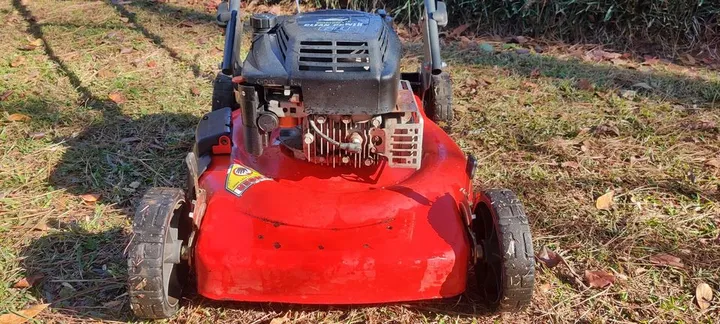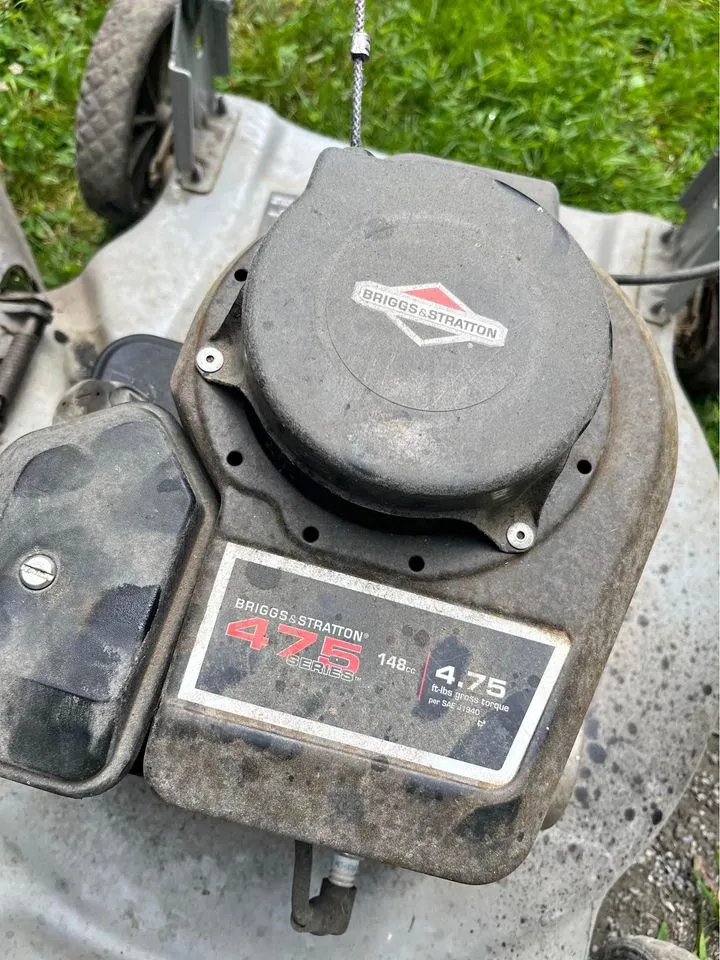As a seasoned garden equipment mechanic with over 10 years of hands-on experience, I’ve encountered and resolved countless cases of push mowers emitting smoke.
In this article, I’ll leverage my expertise to explain why your push mower might be smoking, identifying common causes and practical solutions. My goal is to provide you with clear, actionable information, empowering you to address this issue effectively.
Trust in my guidance as we delve into the intricacies of push mower maintenance, ensuring your equipment’s longevity and optimal performance.
Quick Summary
- Diagnosing smoking in push mowers involves identifying the smoke’s color, with white or blue smoke indicating oil issues and black smoke suggesting an over-rich fuel mixture.
- Regular maintenance, including checking the oil level, air filter, and spark plug, can often resolve smoking issues in push mowers.
- According to consumer reports, most problems with push mowers, including smoking, can be resolved with basic maintenance and servicing.
- In my experience, being proactive with regular maintenance is key to preventing smoking and ensuring the longevity and optimal performance of push mowers.
Learning the Colors: White, Blue, Black Smoke
When I see white or blue smoke billowing from my push mower, it’s often a telltale sign of an oil spill on the engine or an overfilled oil reservoir.
If there’s black smoke, however, I’m likely dealing with a different issue: my mower could be running rich, meaning it’s burning more gasoline than it should.
Identifying the color of the smoke is crucial in troubleshooting and getting my mower back to optimal performance.
Related: Bad Boy Mower Smoking: Quick Fixes You Can Do
White or Blue Smoke May Indicate an Oil Spill on the Engine
Spotting white or blue smoke billowing from your push mower usually signals an oil spill on the engine. When I see this, I know it’s time to check for messes. This type of smoke often occurs if the mower tips over or if I’ve been overzealous with the oil can.
Too much oil can overflow onto hot parts of the engine, causing the smoke.
I always ensure the mower is on level ground and check the oil level before starting it up. If I do find excess oil, I clean it off promptly. It’s important to avoid spills during oil changes too.
An Overfull Oil Reservoir May Also Cause White or Blue Smoke
Understanding the nuances of smoke can prevent costly repairs. Notably, white or blue smoke may also stem from an overfilled oil reservoir in your push mower.
I’ve learned that when there’s too much oil, it can seep into the combustion chamber or exhaust system, where it burns and produces that telltale smoke. It’s a clear sign I need to check the oil level and adjust it if it’s too high.
I make sure to drain the excess oil carefully to avoid any environmental harm or potential fire hazards.
Keeping the oil at the correct level is crucial not just for reducing smoke but also for ensuring the longevity and efficient operation of my mower. It’s a simple step that goes a long way in maintenance.
Black Smoke May Indicate That the Mower is Running Rich, or Burning Too Much Gasoline
While white or blue smoke often points to an oil issue, I’ve noticed that black smoke from my push mower usually signals it’s running rich with too much gasoline in the mix.
This can happen if the carburetor’s out of adjustment or if the air filter’s dirty, restricting airflow. The engine then gets a higher ratio of fuel to air, leading to incomplete combustion and that telltale black smoke.
I make sure to check the air filter first—it’s a common culprit and a quick fix. If that’s clean, I’ll look at the carburetor settings. Sometimes, it’s as simple as adjusting a screw to correct the fuel mixture.
Regular maintenance is key to preventing this, ensuring my mower runs smoothly and smoke-free.
Take Your Mower to a Repair Shop if Necessary

If your troubleshooting efforts haven’t resolved the smoking issue, it’s time to take your push mower to a professional repair shop.
I’ve been there myself, after all the cleaning, checking, and adjusting I could think of, sometimes the problem’s beyond my expertise. I’m not too proud to admit when I need a bit more help.
I look for a reputable repair shop with experienced technicians. I’ll ask friends for recommendations or check reviews online. It’s important to find a place that’s known for their reliability and good service.
I don’t want to hand over my mower to just anyone—it’s a tool I rely on, and I need it running smoothly.
Once I’ve chosen a shop, I make sure to explain the issue in detail. I tell them about the smoke, the color, and when it happens. The more they know, the easier it’ll be for them to diagnose and fix the problem.
Taking my mower in for repairs might cost a bit, but it’s worth it for peace of mind. Plus, I’d rather invest in a proper fix than risk further damage or even injury. It’s all about keeping my trusty mower—and me—in tip-top shape for the mowing season ahead.
The Role of Spark Plugs in Mower Smoking
A common but often overlooked cause of smoking in push mowers is a worn-out spark plug. Spark plugs are crucial for the efficient ignition of fuel in the combustion chamber.
Over time, they can become fouled or damaged, leading to inefficient combustion. This inefficiency can manifest as smoke, indicating incomplete burning of fuel. When the spark plug misfires, it fails to ignite the fuel completely, leading to smoke production.
Regular inspection and replacement of spark plugs can prevent this issue. Ensuring the use of the correct type of spark plug, as recommended by the mower’s manufacturer, is also vital for optimal performance and avoiding smoking issues.
Exhaust Clogs Leading to Smoke
Smoke from a push mower can also be attributed to blockages in the exhaust system. The exhaust system, including the muffler and exhaust pipe, plays a crucial role in expelling exhaust gases from the engine.
When these components become clogged with debris, such as grass clippings or dirt, the engine’s ability to expel these gases is hindered, leading to smoking. Regular maintenance, including checking and cleaning the exhaust system, is essential.
Removing any visible obstructions and ensuring that the exhaust path is clear can significantly reduce the chances of smoking due to exhaust clogs.
Valve Train Problems in Push Mowers
Valve train issues are more complex and can also cause smoking in push mowers. The valve train consists of components that control the intake and exhaust of gases in the engine’s combustion chamber.
Problems like a burnt valve can occur due to overheating, leading to inefficient sealing of the combustion chamber. This inefficiency can result in smoking as the mower fails to burn the fuel-air mixture completely.
A professional mechanic should address valve train problems as they require specialized knowledge and tools for diagnosis and repair. Regular engine checks can help in early detection of such issues.
Detailed Cleaning Instructions for Different Types of Air Filters
The air filter is a critical component in maintaining the engine’s health, and its maintenance is vital in preventing smoking.
For paper air filters, it’s recommended to tap the filter against a solid surface to remove loose dirt and to replace it if it’s extremely dirty or damaged.
Foam air filters require washing with mild dish soap and water, followed by complete drying and re-oiling before reinstallation.
Regular cleaning, based on the mower’s usage, and replacement when necessary, can prevent air flow restrictions that lead to smoking due to a rich fuel mixture.
Learn More: How to Clean Lawn Mower Air Filter
The Importance of Mower Angles and Oil Leaks

Operating a push mower at incorrect angles or tipping it can lead to oil leaks into the combustion chamber, causing smoking.
When mowing on steep inclines or if the mower is accidentally tipped, oil can seep into areas where it gets burnt, leading to blue or white smoke. Ensuring that the mower is used at recommended angles and is stored properly can prevent such issues.
Additionally, checking for and addressing oil leaks promptly is crucial. Leaks can occur due to worn seals or gaskets and should be fixed to prevent smoking and potential damage to the engine.
Our Verdict
In my journey with push mowers, I’ve learned to read their smoke signals like a seasoned pro.
White or blue smoke? That’s often my cue to check for oil spills or an overfull reservoir.
And black smoke? Time to inspect for a rich fuel mixture or a dirty air filter.
I’ve found that being proactive with these issues saves a heap of trouble. From my personal experience, regular maintenance checks are a game-changer. But, when the problem’s out of my league, I don’t second-guess taking it to a professional.
After all, there’s nothing like the satisfaction of a smoothly running mower and a neatly trimmed lawn. Let’s keep those mowers happy and our grass greener!
Frequently Asked Questions
Can mowing certain types of grass or debris cause my push mower to smoke unexpectedly?
Mowing over wet grass or hitting debris might cause my mower to smoke. It’s straining the engine, leading to burning oil or overheating, which I’ve noticed can result in unexpected smoke.
How can I differentiate between normal exhaust and the onset of a smoking issue with my mower?
I’ll look for excessive smoke that’s not clear, a sign of a problem. Normal exhaust is relatively thin and dissipates quickly; anything else, I’m checking for issues with oil or overheating.
Will a smoking mower cause long-term damage if I continue to use it before it’s repaired?
Continuing to use a malfunctioning piece of equipment could lead to further damage. I’d stop using it and get it fixed to avoid any long-term problems that might be more costly.
How often should I perform maintenance checks on my push mower to prevent smoking issues?
I perform maintenance checks on my push mower every 50 hours of use or at least once a season to prevent any issues, including potential smoking, from arising during operation.
Are there any diy troubleshooting steps I can take before deciding to take my mower to a repair shop?
I can check the air filter, spark plug, and oil level myself before considering a professional repair. These simple steps might resolve the issue without needing to visit a shop.

![Why Is My Push Mower Smoking [Common Causes + Fixes]](https://yardsimply.com/wp-content/uploads/2024/01/Why-Is-My-Push-Mower-Smoking-Common-Causes-Fixes.png)
